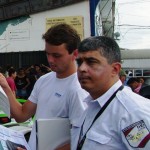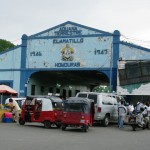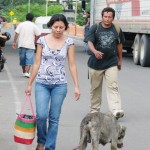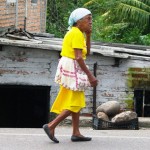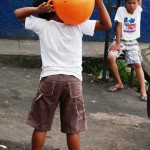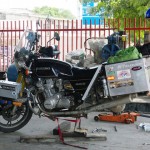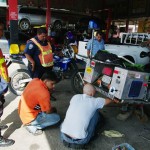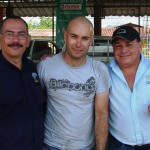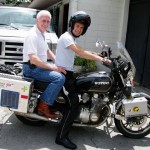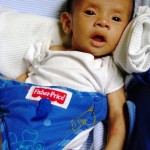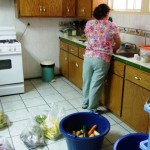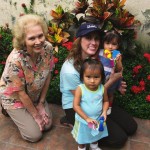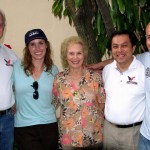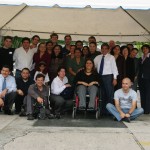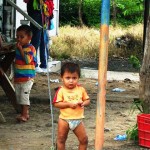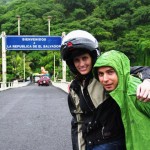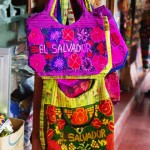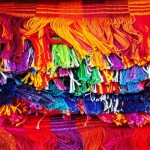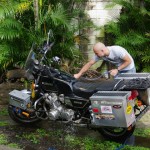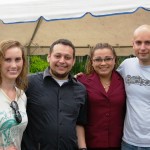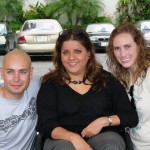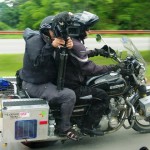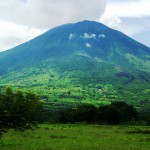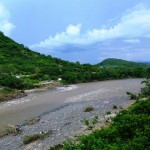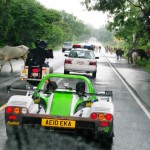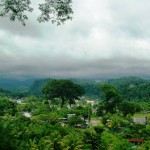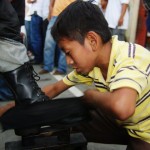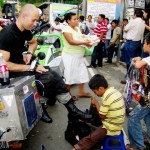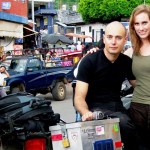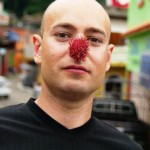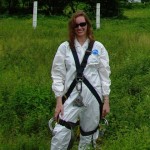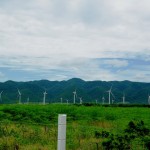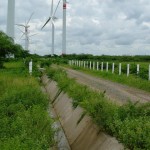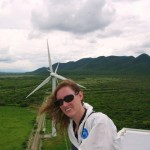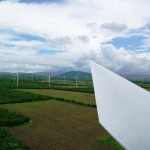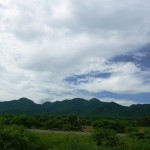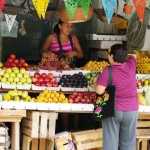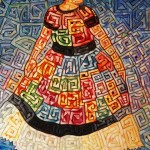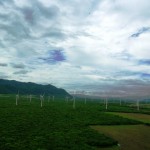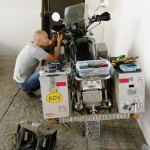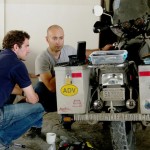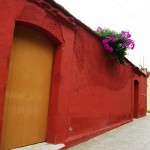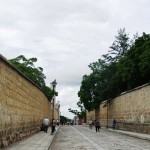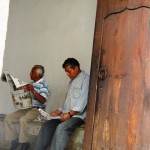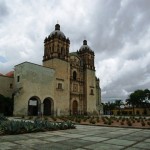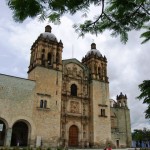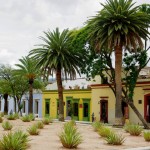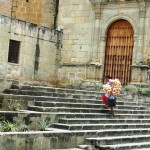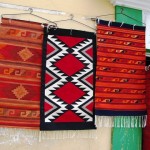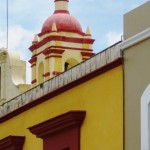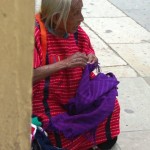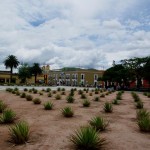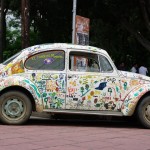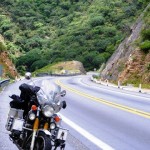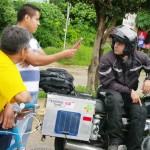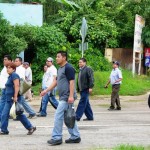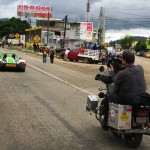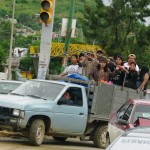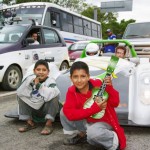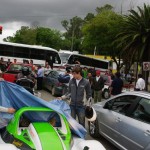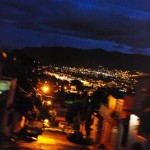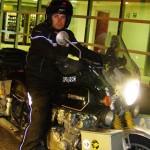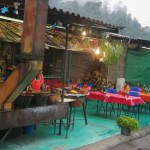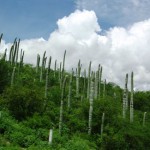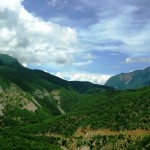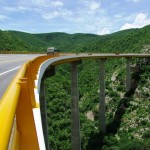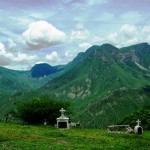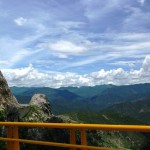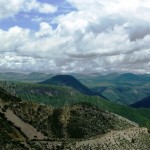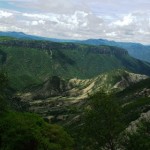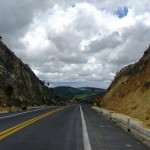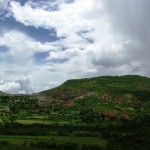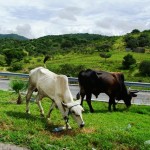November 4th, 2010 - Potholes in Honduras
We left El Salvador amidst warm farewells from our new friends and with a police escort arranged by KPMG. Before we left, Edgar gave us a blue flashing police light, and I mounted it on the left front box. It’s fascinating to see how the traffic gets out of your way with a $6 light, and no one questions your identity. The rain made its customary appearance for part of the trip but abated by the border. We had made good time and were eager to do the border crossing and get to our destination. However, with all the good border crossings and encounters with police that we had so far, it was only a matter of time before we ran into one unscrupulous border agent. The mention of the word “embassy” (The RGE Team has letters from the British Embassy) didn’t seem to settle well with this guy who proceeded to detain us for 5 hours while everyone else was blithely passing on through. Of course, as with any stop we make, the SRZero and the bike were immediately surrounded by curious little and big people wanting to know about the car and bike and take pictures with their cell phones and cameras.
While waiting at the border we met some raw-food vegan cyclists from the US who were pushing to get to Panama on single gear bikes! They had no saddlebags, no tent or sleeping bag and what they wore was what they had. They slept at gas stations whenever they couldn’t stay awake to bike anymore and ate nuts and fruits to stay alive. I don’t know how they do it as I would die if I didn’t eat meat for one day. We wish them a safe and successful journey. Cynthia got a warm welcome to Honduras by a zealous bee, and while that sucker stung, the welt it left wasn’t any bigger than that of the monster mosquito bites she had acquired. In the end the whole delay at the border was solved by a “deal” between our overly friendly, conveniently English-speaking “fixer” and the grumpy border patrol man. Of course this deal involved paying some wads of cash.
We started not liking Honduras from the very start, and it kept getting worse. When we were “allowed” to cross the border, it was already dark and our destination was 200k away. The rain came down lashing again, and the roads turned into Swiss cheese. The potholes got bigger and bigger to the point that it was hard to go any speed higher that 25mph. I radioed back to the SRzero and the van with directions on how to avoid each pothole. We got stuck behind a long truck line, and as I tried to pass, I sped up and entered the other lane and there it was: an abyss as wide as the road. I broke hard, but it wasn’t enough, and we hit the hole with full force. The headlight went black, the front brake caliper jammed and the suspension bottomed out to the point that I heard a crack on my spine.
We limped to our destination about a mile away, and I started assessing the damage. The front rim was bent, sticking out about an inch. The right caliper was jammed, and the brake rotor was almost red from the heat. The headlight was busted, one fog light was out and a marker light lens broken. I started by dumping water on the rotor to cool it off and took the caliper apart. One of the slides was bent from the knock force, and it caused the jam. I hammered the slide back to shape and filed away the burrs, and it worked. The rim was more serious, and it took some precise banging and bending to get back to shape. When I got done with it, it was almost unnoticeable.
We ended up staying at the Lufassa power plant which provides approximately 33% of the Honduran electricity. We were hosted by Juan, the manager of the plant who took us to dinner at a seaside German restaurant. Juan was a very nice guy, and gave us a tour of his power plant which was impressive.
We left early the next morning to get to the Nicaraguan border, but as we entered the town of Choluteca, the rear tire went flat, our first flat of the trip. To my astonishment, the RGE team couldn’t be bothered to wait for us and left us there with no help and continued on to have their lunch and cross into Nicaragua! Thankfully Juan came to our aid and had one of his guys go tube hunting with me. Finding the tube was the easy part, and we proceeded to a tire shop to change the tire. I took the wheel off, and the shop changed the tire for $5 USD. Juan arranged our own motorcycle police escort to the border, and we were home free. I’m still amazed that after helping the RGE guys out so much through these potholes, night after night, in the rain and in the middle of the night, they could just leave us there. I’m not doing this for money, and I can take care of myself just fine, but their lack of consideration made me uneasy. Claudio ended up having to yell at them and stop them at the border to at least wait for us.

